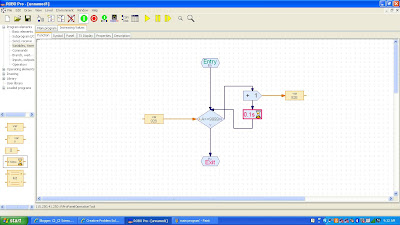The Challenge: Build an assembly line out of Fischertechnik parts. The assembly will be based on marking the sides of 6 individual dice.
Achievment Get!
Total Achievments: 15
Class Achievments
"Implementation"
The entire class had to work together on this one. Despite some setbacks, and some faulty programing, we got it done. Only downside, it took around 6 weeks and we only got through 4 cubes.
"Stewardship"
Took a while, but we got it done. I did my part, but I wasn't a huge contributor. That credit goes to Nicky and Tom, who spent a good week reorganzing all the parts.
Team Achievments
"Flash of Inspiration"
FLASH. AAAAHHH. SAVIOR OF THE UNIVERSE. http://www.youtube.com/watch?v=cyIIYerdlUA
On a serious note:

"If you Build It..."
Built it. Such a beautiful piece of building blocks, sensors, motors, and pistons.
"Proof is in the Pudding"
After some work, we got it to fit both the needs of the part in front of us and behind us. The part in front of us took the longest to fit in with ours.
"Round and Round We Go"
Our first problem was trying to get ours to fit the machine behind us. Worked this out by adding an angle and just letting the dice simply dropping onto our coonveyer belt.
"Round and Round We Go... Again"
Next challenge! The hardest part of this entire project was the final part: getting the cubes packed. It orginally would get 1 out of 4 dice up, every other time it would fall down its conveyer belt and hit ours. This backed ours up, causing our timed programing to get thrown off. In the end, we commandeered this project (got a little backlash out of this).
"
At one point, our station was having cubes getting caught on the light sensor. All we needed to do was slide the sensor over a little so it wouldn't catch the cubes. After a brief check, we made sure that this implementation worked, and also checked for any other defects in our design.
"Lab Rat"
What we have here is data for the entire assembly line. Our station was station 6. We collected the amount of time it takes for each station to mark its die. The class used this data to figure out the total time it took for each die.
"Show Me"
(Chart courtesy of Tom. The numbers refer to the stations in the previous table, and the charft shows how much time each station took compared to the others.)
"Leave no Trace"
I don't see any fischertechnik pieces here. Whatever could you be talking about? Oh, that project? Its gone now, you just missed it.
Individual Achievments
"Share It"
I was always asking the station after us to fix their design. The cubes kept falling down their conveyer belt and blocking up ours. After a while, Tom and I just jumped into their project to fix it, mainly because we were annoyed by the amount of progress they had made on fixing the problem (0%) and their tendency to be off task,.
"Keep the Customer in Mind"
I'll leave this up to you to decide how easy this is for you to read.
"Nice One!"
Marcos was the most helpful member to our project, always telling us when something was going wrong with our station, or where we might need to improve our design.
"Helping Hand"
I helped Gustavo with some programming for his station. He was having a bit of trouble finding the right functions, and couldn't figure out why the timing was always off. Fixed a few kinks here and there, and we determined the timing was off due to the change in light.




























